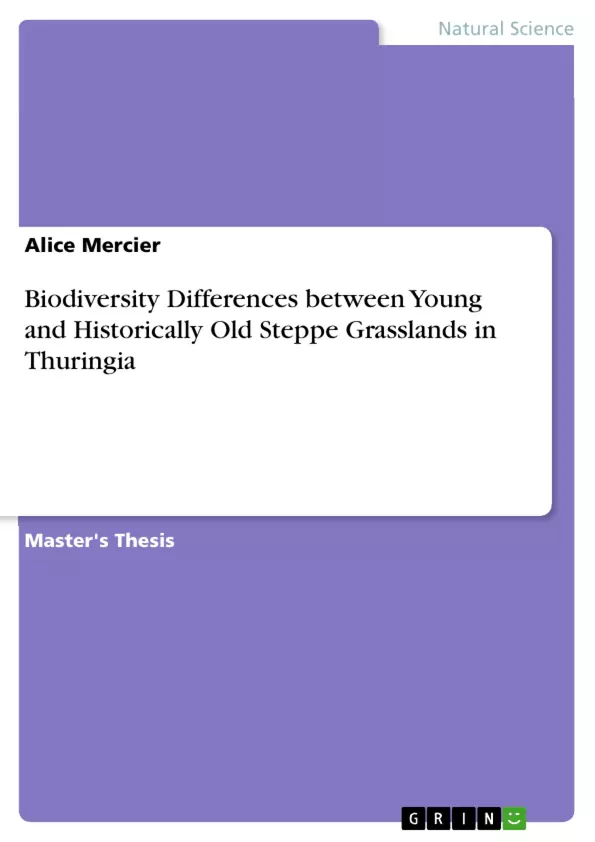Generally there are only few studies that focus on the interrelation of species composition, habitat properties and indicator species of young and old grasslands , and the few existing oftentimes have contradictory findings. This is surprising, as decision-makers are oftentimes forced to concentrate efforts on areas of highest conservation value due to financial restrictions.
In this study, we assumed that habitat age and land-use history have verifiable effects on the present vegetation community. We analyzed a total of 14 study sites at the southern slopes of the Kyffhäuser Mountains, at the northern border of the federal state of Thuringia, Germany. The area is renowned for its richness in fauna and especially flora, constituting the western-most outpost of Eurasian steppic grasslands. The study area was analyzed with the help of historical maps, post-war aerial survey photographs and presentstate orthophotographs. For each study site 12 relevés, 6 on historically old and 6 on relatively young grasslands on former arable land were conducted. A total of 88 environmental variables ranging from Ellenberg Indicator Values, orographic and edaphic conditions, soil contents and properties, to species inherent traits, were tested for their power to explain the observed occurrence and abundance patterns. Results clearly show that land use history and habitat age has a significant effect on species composition. Concordantly, an Indicator species analysis identified 28 indicator species for old and 21 for young calcareous grasslands. Most significant differences between the two groups were the Ellenberg Indicator Values for moisture and nutrients for the occurring species, which were much higher for young sample sites. Accordingly, there was a higher proportion of ruderalists on grasslands of younger age, while old patches were dominated by stress-strategists. In total, strong relationships could be found for 17 of the tested variables. While α-diversity was only slightly higher for old sites, occurrence of threatened species was more than doubled.
We conclude that the identification of historic calcareous grassland patches is desirable and, where absolutely necessary, old sites should take precedence in management efforts over sites of younger origin. However, considering recent findings in literature, ideally a mosaic of different successional stages should be aspired for, as it can harbor the widest range of plant species and associated invertebrates.
Inhaltsverzeichnis (Table of Contents)
- ABSTRACT
- INTRODUCTION
- 1.1. BACKGROUND
- MATERIAL AND METHODS
- 2.1. The Study Area
- 2.2. Area Analysis and Vegetation Sampling
- 2.3. Laboratory Soil Analysis
- 2.4. Species Biological Traits, Indicator Values and other Parameters
- 2.5. Statistical Analysis
- RESULTS
- 3.1. Diversity Measures
- 3.2. Indicator Species
- ORDINATIONS
- 4.1.1. DCA
- 4.1.2. NMDS
- DISCUSSION
- 5.1. Field Work
- 5.2. Ordinations
- 5.2.1. Environmental Variables & Life Strategy Types
- 5.2.2. Species Dispersal & Seed Longevity
- 5.3. Diversity and Conservational Values
- 5.4. Management
- 5.5. Conclusion
- APPENDIX
- ACKNOWLEDGEMENTS
- REFERENCES
Zielsetzung und Themenschwerpunkte (Objectives and Key Themes)
This master thesis investigates the relationship between species composition, habitat properties, and indicator species of young and old grasslands. The study aims to determine if land-use history and age have a significant impact on the present vegetation community. This research explores the biodiversity differences between young and old steppe grasslands, particularly focusing on the impact of land-use history and habitat age on species composition and diversity.
- Influence of land-use history and age on vegetation community
- Biodiversity differences between young and old grasslands
- Indicator species for young and old calcareous grasslands
- Environmental factors affecting species occurrence and abundance patterns
- Conservation implications for management and preservation of grasslands
Zusammenfassung der Kapitel (Chapter Summaries)
The introduction provides background information on the historical development of calcareous grasslands and the impact of human influences on their formation and persistence. The study area, located in the Kyffhäuser Mountains, is described, highlighting its unique biodiversity. Chapter 2 details the methods used for area analysis, vegetation sampling, laboratory soil analysis, and statistical analysis. Chapter 3 presents the results of the study, including diversity measures and indicator species analysis, highlighting the significant differences in species composition between young and old grasslands. Chapter 4 explores the use of DCA and NMDS ordinations to analyze environmental variables and their influence on species patterns. Chapter 5 discusses the findings, focusing on the impact of environmental variables and life strategy types, species dispersal, and seed longevity on vegetation composition. It also delves into the diversity and conservation values of young and old grasslands, concluding with recommendations for management practices.
Schlüsselwörter (Keywords)
This master thesis explores the key concepts of biodiversity differences, land-use history, habitat age, indicator species, calcareous grasslands, vegetation community, species composition, and management implications for conservation. The study utilizes methods such as DCA and NMDS ordinations to analyze environmental variables and their influence on species patterns, leading to valuable insights into the impact of human activities on grassland ecosystems.
- Quote paper
- Alice Mercier (Author), 2012, Biodiversity Differences between Young and Historically Old Steppe Grasslands in Thuringia, Munich, GRIN Verlag, https://www.grin.com/document/911577



